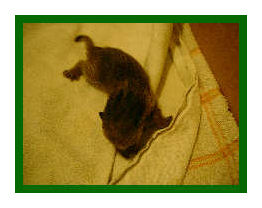Peetie's Story
It was right as I was running out of the door to my first braided rug class. I glanced out the back sliding glass doors at the deck and something caught my eye. It was a baby something. I did not know what it was. It had to have dropped at least 8 feet from the eves and had been there long enough for a very large bump to form on its head where it landed.
My husband identified
the baby as a raccoon. It still had its umbilical cord attached and the eyes were tightly closed. It was alive, naked, and getting cold. I ran inside with it-- it turned out to be a her, and found a large shoe box. I put some soft layers on the bottom, gently covered her up, and put the shoebox and all on top of a heating pad set to low. I went to class late.
When I came home I feed her warm milk through an eyedropper with some success. My husband found, through the web, that there was someone, a licensed fauna rescue goddess, who could tell us how to care for the infant raccoon. We contacted her and followed her instructions. Baby raccoons need to drink
warm kitty formula every four hours at infancy. Four days later there was another one. This one was a he, with a big bump. This one was Peetie. Needless to say, every time I walked past the back sliding door, I kept an eye out for more babies.
 The
tiny female did not make it, her bump never receded. Peetie's bump eventually disappeared. He grew fast. He was fed every four hours except at night, when I had to sleep. First thing in the morning Peetie was fed. It was almost like having a newborn again. Gradually the time in between feedings increased. When he seemed to get sick, the raccoon specialist told me to try colloidal silver drops. It saved his life more than once. The
tiny female did not make it, her bump never receded. Peetie's bump eventually disappeared. He grew fast. He was fed every four hours except at night, when I had to sleep. First thing in the morning Peetie was fed. It was almost like having a newborn again. Gradually the time in between feedings increased. When he seemed to get sick, the raccoon specialist told me to try colloidal silver drops. It saved his life more than once.
With all the other animals in our home I had to be careful about germs coming out to my cats and dogs or going into Peetie. He had his own room, the upstairs bathroom. I had to wash and disinfect my hands before and after touching and feeding him, then wash dishes and bottles. I always wore an apron when handling him for any reason and took it off before I left the bathroom. It was an enormous amount of work, but very well worth it.
By far, the hardest thing for me to do was to keep in mind, at all times, that he was not my pet, but a wild animal that must be returned to his land. That day came all too soon at around age six months or so, and he did not want to go. He was not used to being nocturnal, which is why I have photos of Peetie in his tree during daylight hours. He did not know what he was or what one of his own even looked like.
He hung around the house and I fed him as much as I could in his transition period while he was making so many new discoveries. He ate kitty food and sour cream all fall and winter. I left it on the edge of the deck. Eventually he found companions and came to feed here less and less as I was also tapering the food. Now I do not see him at all. He used to come to me outside when I called him. When I think of him out there, the baby I once raised, the little life I was
grateful to save, out there in the dark and cold, I feel sad, tears come to my eyes. Deep inside I know, however, that he is where he was born to be, where he belongs. I would do it again tomorrow.

|
